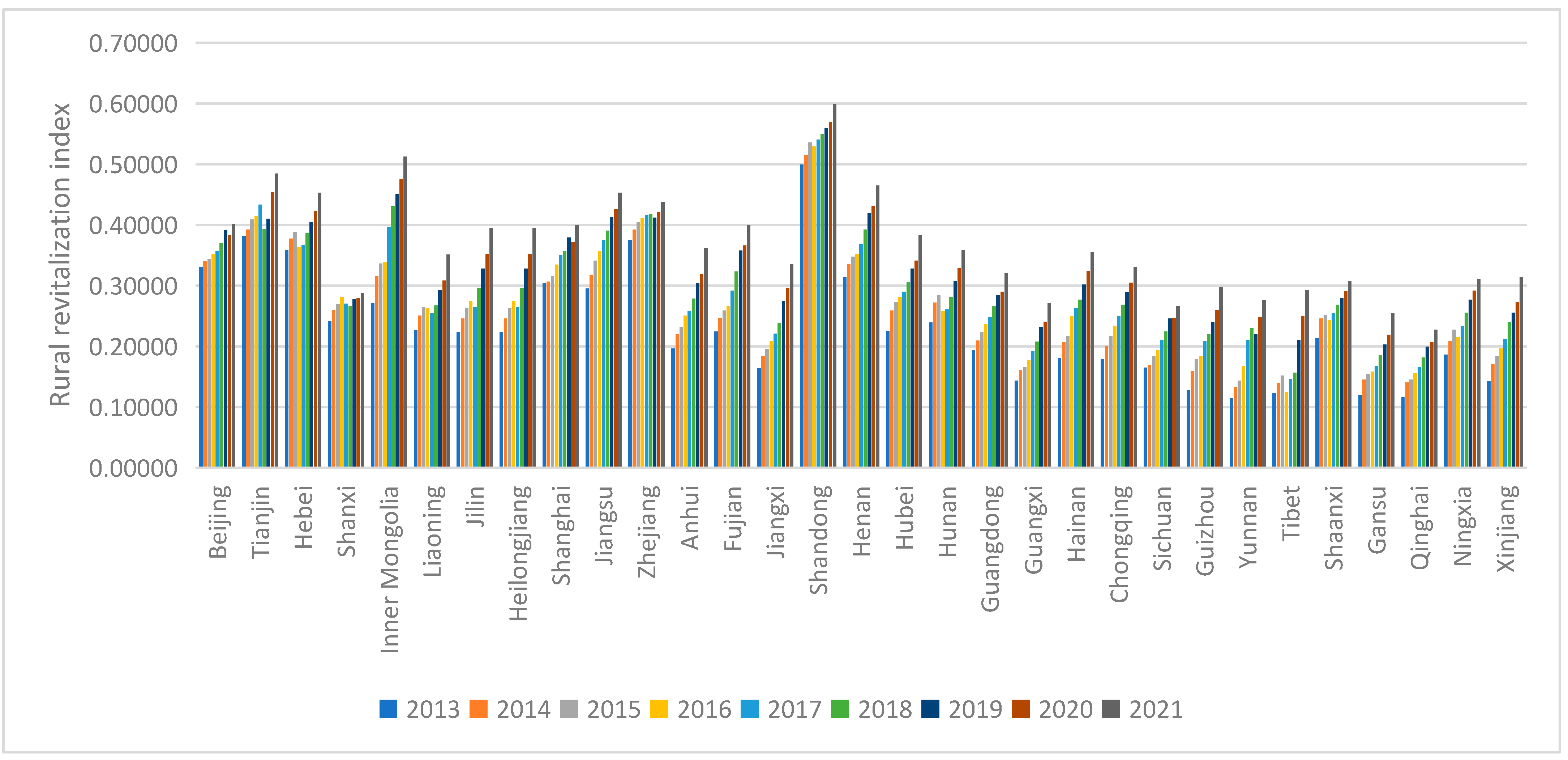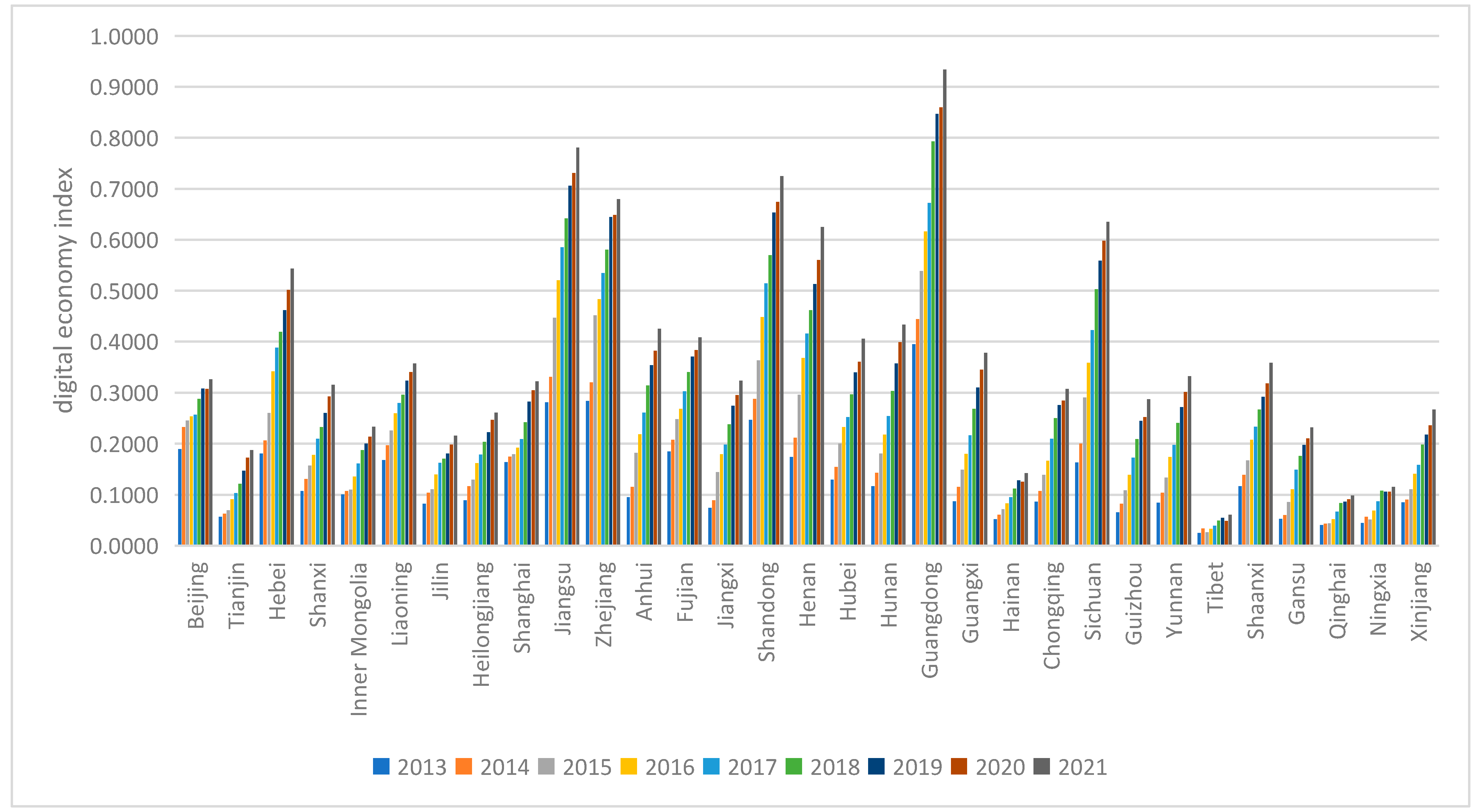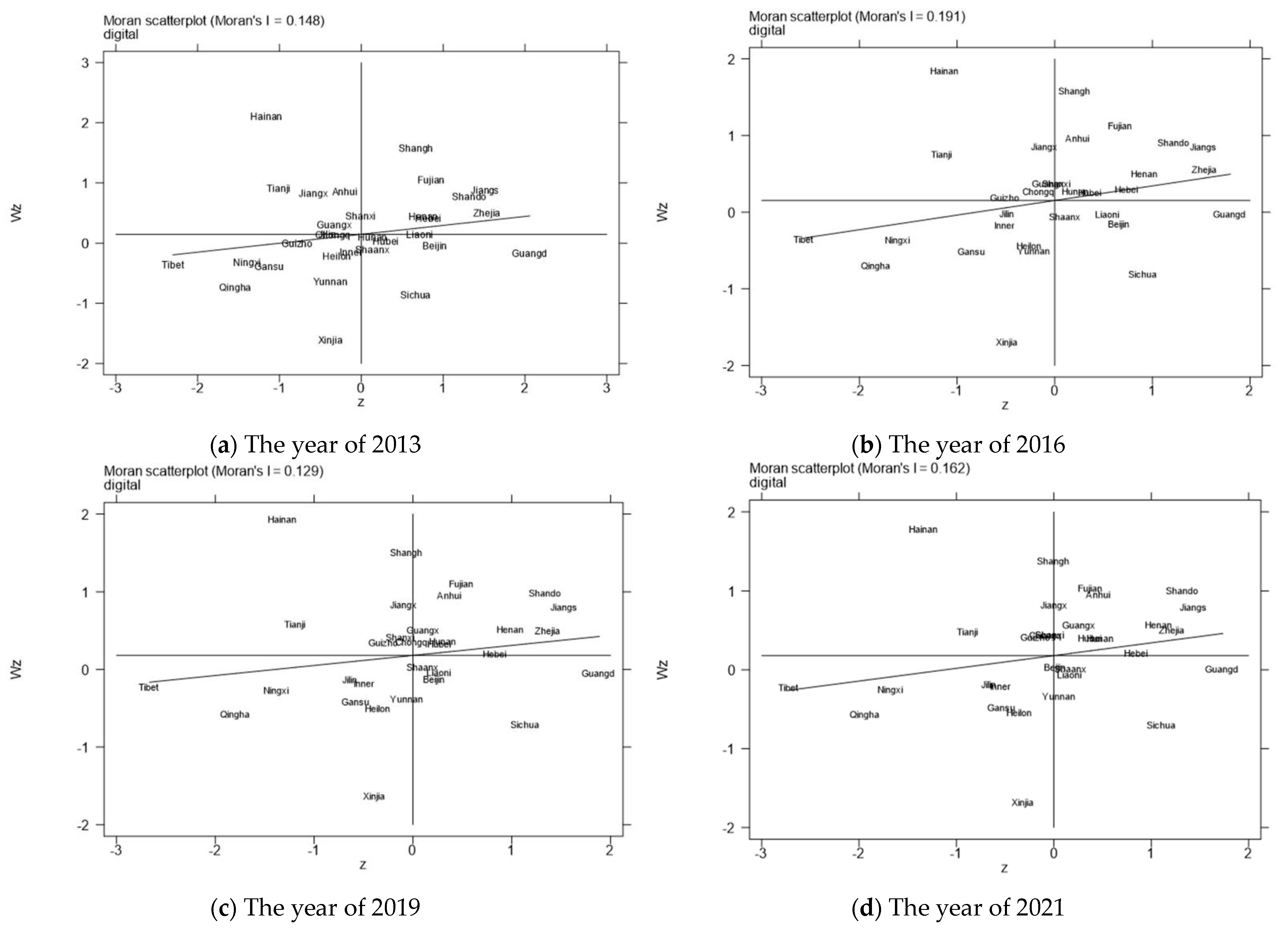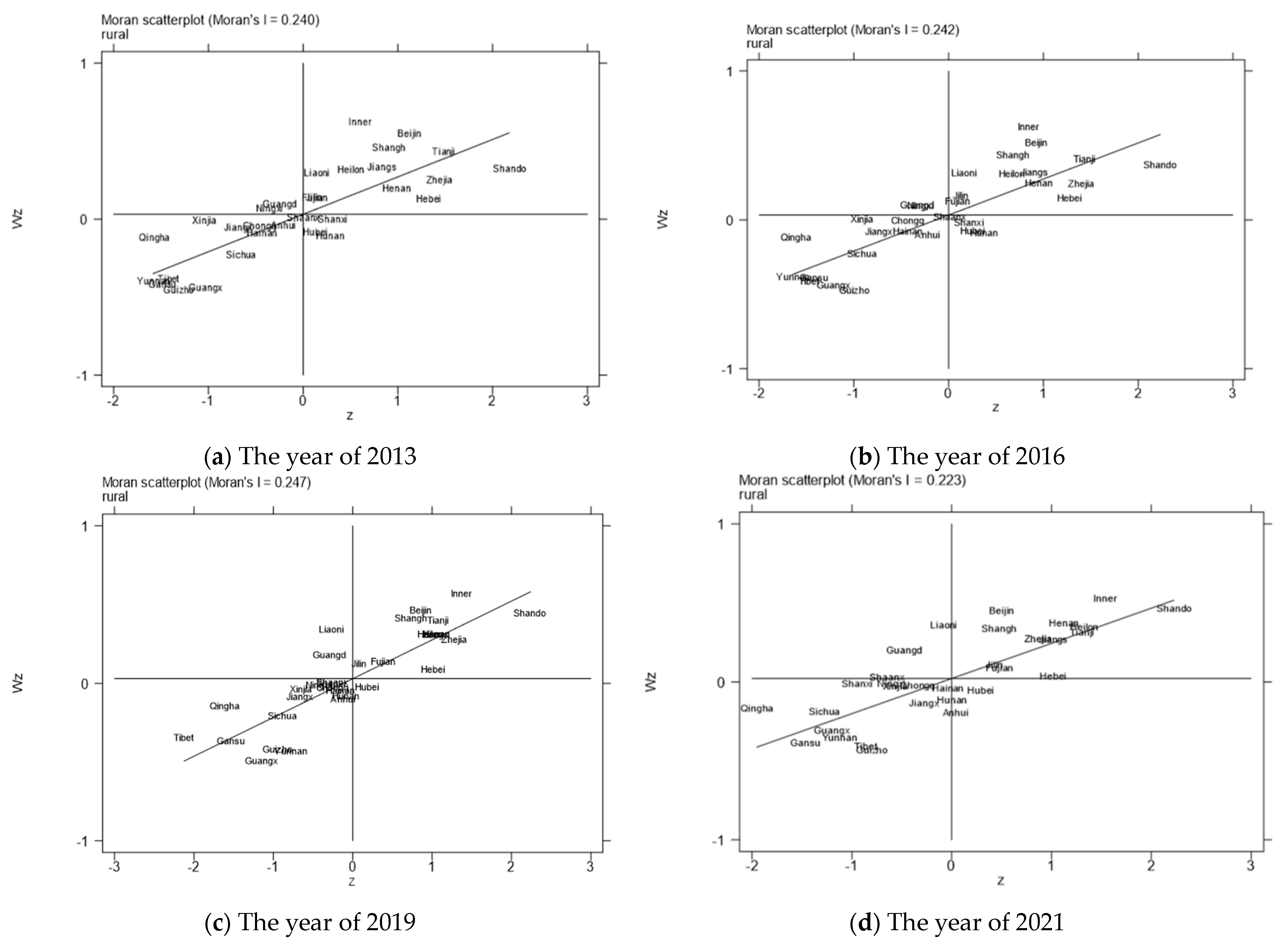Research on the Impact Mechanism and Spatial Spillover Effect of Digital Economy on Rural Revitalization: An Empirical Study Based on China’s Provinces
Abstract
:1. Introduction
- (1)
- Most existing theoretical analyses focus on the concept definition, connotation interpretation, policy design and implementation path of the digital economy and rural revitalization. Still, there is a lack of empirical research on them.
- (2)
- The few existing empirical studies only focus on the local influence of a particular dimension but do not consider the relationship between the two from a global perspective, let alone an in-depth influence mechanism.
- (3)
- Existing studies lack spatial effect studies on the digital economy and rural revitalization.
- (1)
- For the first time, the paper brings the digital economy and rural revitalization into the same empirical analysis framework and explores whether the digital economy drives rural revitalization.
- (2)
- The paper explores the impact mechanism of digital economy-driven rural revitalization using a mediating effect model by selecting industrial structure transformation and rural entrepreneurship as mediating variables.
- (3)
- The spatial spillover effects of the digital economy and rural revitalization are explored using the spatial Durbin model.
2. Theoretical Analyses and Research Assumptions
3. Research Method and Data Resource
3.1. Benchmark Regression Model
3.2. Mediating Effect Model
3.3. Description of Data and Variables
3.3.1. Explained Variable
3.3.2. Core Explanatory Variable
3.3.3. Control Variables
3.3.4. Mediating Variable
3.3.5. Data Sources
3.3.6. Entropy Weight Method
- (1)
- Index selection: assuming that there are t years, i years, and j indicators, is the j index value of province i in the t year.
- (2)
- Standardization of indicators: because different indicators have different dimensions, they need to be standardized.
- (3)
- To avoid the logarithm being meaningless when calculating the entropy , the data is translated:
- (4)
- Calculate normalized p value:
- (5)
- Calculate the entropy value of the jth indicator: , where , m represents the number of provinces, n represents the number of years.
- (6)
- Calculate the information utility value of the jth indicator: .
- (7)
- Calculate the weight of each indicator:
- (8)
- The method of weighted summation of weight and index is used to calculate the comprehensive evaluation index:
3.3.7. Spatial Durbin Model
4. Results and Analysis
4.1. Benchmark Regression Analysis
4.2. Mediation Mechanism Test
4.3. Robustness Test
4.3.1. Endogenous Test
4.3.2. Robustness Test
5. Spatial Spillover Effect
5.1. Global Moran’s Index
- (1)
- Economic distance matrix (U): matrix element , where represents the per capita GDP of the province ith from 2013 to 2021.
- (2)
- Geographical distance Matrix (V): matrix element , where dij indicates the distance between the provincial capitals of the two provinces.
- (3)
- This article takes the economic geographic distance nested matrix (W): , is the weight, considering the equal importance of the economic distance matrix and geographical distance matrix .
5.2. Moran Scatter Plot
5.3. Spatial Spillover Effect and Model Determination
Robustness Test
6. Discussion and Conclusions
Author Contributions
Funding
Informed Consent Statement
Data Availability Statement
Acknowledgments
Conflicts of Interest
References
- Bukht, R.; Heeks, R. Defining, Conceptualizing and Measuring the Digital Economy. Int. Organ. Res. J. 2018, 13, 143–172. [Google Scholar]
- Cai, Y. Measurement of added value and contribution of Digital economy: Historical evolution, theoretical basis and methodological framework. Qiushi Acad. J. 2018, 45, 65–71. [Google Scholar]
- Ouyang, R. Theoretical Evolution, Connotation Characteristics and Development Law of Digital Economy. Guangdong Soc. Sci. 2023, 219, 25–35+286. [Google Scholar]
- Margherio, D.; Henry, S.; Cooke, S.; Montes, S.; Hughes, S. The Emerging Digital Economy, Secretariat on Electronic Commerce; U.S. Department of Commerce: Washington, DC, USA, 1998.
- Haltiwanger, J.; Jarmin, R.S. Measuring the Digital Economy. In Understanding the Digital Economy: Data, Tools, and Research; Brynjolfsson, E., Kahin, B., Eds.; MIT Press: Cambridge, MA, USA, 2000. [Google Scholar]
- Moulton, B.R. GDP and the Digital Economy: Keeping up with the Changes. Underst. Digit. Econ. Data 1999, 5, 34–48. [Google Scholar]
- Zhang, W.; Bai, Y. The theoretical construction, empirical analysis and optimization path of the coupling of digital economy and rural revitalization. Soft Sci. China 2022, 373, 132–146. [Google Scholar]
- Tian, Y.; Ye, Y.; Huang, J.; Liu, Q. The Internal Mechanism and empirical Test of Rural Industrial Revitalization driven by Digital economy—Based on the intermediary effect of urban-rural integration and development. Agric. Econ. Probl. 2022, 514, 84–96. [Google Scholar]
- Han, L.; Chen, S.; Liang, L. Digital Economy, Innovation Environment and Urban Innovation Capability. Sci. Res. Manag. 2021, 42, 35–45. [Google Scholar]
- Ye, X.; Du, Y.; He, W. Structural effects of employment in the development of digital economy. Financ. Trade Res. 2021, 32, 1–13. [Google Scholar]
- Cheng, W.; Qian, X. Digital economy and Green Total Factor Productivity growth of Chinese Industry. Explor. Econ. Issues 2021, 469, 124–140. [Google Scholar]
- Zhao, X.; Wang, W.; Li, X. How does Digital Transformation affect Enterprise Total Factor Productivity. Financ. Trade Econ. 2021, 42, 114–129. [Google Scholar]
- Li, Z.; Yang, Q. How does the digital economy affect the high- quality development of China’s economy? Discuss. Mod. Econ. 2021, 475, 10–19. [Google Scholar]
- Zhao, T.; Zhang, Z.; Liang, S. Digital economy, Entrepreneurial activity and High-quality Development-empirical evidence from Chinese cities. Manag. World 2020, 36, 65–76. [Google Scholar]
- Yan, Z.; Wu, F. From binary Division to Integrated Development: A study on the Evaluation Index system of Rural Revitalization. Economist 2019, 246, 90–103. [Google Scholar]
- Zhang, T.; Li, M.; Xu, Y. Construction and empirical study of Evaluation Index system of Rural Revitalization. Manag. World 2018, 34, 99–105. [Google Scholar]
- Jia, J.; Li, X.; Shen, Y. Index system Construction and empirical Analysis of Rural Revitalization Strategy. Financ. Sci. 2018, 368, 70–82. [Google Scholar]
- Yao, J.; Ni, L. Research on the Strategy of promoting the Integration of small Farmers into Rural Revitalization. Theor. Discuss. 2021, 221, 97–101. [Google Scholar]
- Wu, M.; Wang, Y.; Li, Q. Multiple effects of Rural Culture and Tourism small and Micro Enterprises in promoting Rural Revitalization. J. Tour. 2021, 36, 5–7. [Google Scholar]
- Deng, Z. Government officials live broadcast “brings goods”: Live broadcast of government affairs + innovative development, risk challenges and long-term mechanism of assisting farmers. China Adm. 2020, 424, 80–85. [Google Scholar]
- Li, H.; Deng, G. Research on the New Endogenous Development Path of Social Forces Participating in Rural Revitalization: Based on the Comparison of Four Cases. China Adm. 2021, 431, 15–22. [Google Scholar]
- Lu, X.; Deng, Y. Discussion on the mutualistic symbiotic relationship between the collective and the individual under the background of rural revitalization: Based on the experience of Bao Village in Sichuan Province Case study. J. China Agric. Univ. (Soc. Sci. Ed.) 2021, 38, 30–42. [Google Scholar]
- Tang, H.; Li, S. E-commerce, poverty alleviation and rural revitalization: Role and path. Guangdong Univ. Financ. Econ. 2020, 35, 65–77. [Google Scholar]
- Yu, C.; Ren, C. Rural financial support for industrial development: Experience of poverty alleviation and enlightenment of rural revitalization. Economist 2021, 266, 112–119. [Google Scholar]
- Shi, D.; Wang, Y. Influencing factors and policy promotion of the quality of migrant workers returning home to start a business from the perspective of rural revitalization. Qiushi Acad. J. 2021, 48, 90–101. [Google Scholar]
- Ma, X.; Liu, Y.; Tan, J. The practice and Development path of Tourism-driven Rural Revitalization: A case study of Wulingyuan District of Zhangjiajie City. Geogr. Sci. 2020, 40, 2019–2026. [Google Scholar]
- Chu, J.; Cao, Z. Theoretical model construction of science and technology support path for rural revitalization strategy. J. Anhui Univ. (Philos. Soc. Sci. Ed.) 2020, 44, 133–143. [Google Scholar]
- Qi, W.; Zhang, Y. Boosting high-quality development of rural economy with digital economy. Theor. Explor. 2021, 249, 93–99. [Google Scholar]
- Wang, Y.; Sun, N. Digital economy empowers rural development: The promotion mechanism and path of effective connection between poverty alleviation and rural revitalization. E-Government 2023, 1–13. Available online: http://kns.cnki.net/kcms/detail/11.5181.tp.20230413.0852.002.html (accessed on 7 June 2023).
- Chugunov, A.V.; Bolgov, R.; Kabanov, Y. Envisioning Smart Villages Through Information and Communication Technologies-A Framework for Implementation in India. In Proceedings of the [Communications in Computer and Information Science] Digital Transformation and Global Society, St. Petersburg, Russia, 22–24 June 2016; Volume 674, Chapter 46. pp. 463–468. [Google Scholar] [CrossRef]
- Shen, F.; Yuan, H. Digital rural governance in the era of big data: Practical logic and optimization strategies. Agric. Econ. Issues 2020, 490, 80–88. [Google Scholar]
- Chen, Y. Mechanism innovation of the integrated development of digital economy and rural industry. Agric. Econ. Probl. 2021, 504, 81–91. [Google Scholar]
- Kupriyanova, M.; Dronov, V.; Gordova, T. Digital Divide of Rural Territories in Russia. AGRIS Online Pap. Econ. Inform. 2019, 11, 85–90. [Google Scholar]
- Zhao, D.; Ding, Y. Mechanism, Path, and Countermeasures of Digitalization to Promote Rural Revitalization. J. Hunan Univ. Sci. Technol. (Soc. Sci. Ed.) 2021, 24, 112–120. [Google Scholar]
- Guo, C.; Miao, Y. The Mechanism and Path of Digital Economy Promoting Rural Industrial Revitalization. J. Beijing Univ. Technol. (Soc. Sci. Ed.) 2023, 23, 98–108. [Google Scholar]
- Liu, L.; Zhang, Y.; Bi, Y. Digital Rural Assistance in Rural Revitalization: Internal Mechanisms and Empirical Testing. World Agric. 2022, 518, 51–65. [Google Scholar]
- Wan, S.; Tang, K. Research on the mechanism and path of digital economy promoting the revitalization of rural industry. Zhongzhou Acad. J. 2022, 303, 29–36. [Google Scholar]
- Zhang, F.; Deng, B. The impact mechanism and spatial effects of digital economy empowering rural revitalization. Financ. Econ. 2023, 548, 65–76. [Google Scholar]
- Meng, W.; Zhang, G.; Zhao, F. Digital Economy Empowering Rural Revitalization: Impact Mechanisms and Spatial Effects. Res. Financ. Issues 2023, 472, 32–44. [Google Scholar]
- Jiang, J.; Zhao, Y.; Liao, M. Promoting the coordinated development of new urbanization and rural revitalization through rural “double innovation”. Chongqing Soc. Sci. 2020, 306, 98–106. [Google Scholar]
- He, L.; Wang, F.; Wang, C. How does the digital economy drive the revitalization of China’s rural areas? Econ. Explor. 2022, 477, 1–18. [Google Scholar]
- Huang, Q.; Yu, Y.; Zhang, S. Internet development and manufacturing productivity improvement: Intrinsic mechanism and China’s experience. China Ind. Econ. 2019, 377, 5–23. [Google Scholar]
- Yuan, F.; Shi, Q. Can Entrepreneurship Reduce Rural Poverty Return—Empirical Study Based on National Fixed Observation Point Data in Rural Areas. Rural. Econ. 2019, 444, 62–69. [Google Scholar]
- Jiang, X.; Zhai, X.; Wang, Q. Dynamic research on the level of high-quality economic development in my country from the perspective of new development concepts—Interprovincial panel data based on entropy weight method. Stat. Manag. 2019, 268, 109–113. [Google Scholar]
- Nunn, N.; Qian, N. US food aid and civil conflict. Am. Econ. Rev. 2014, 104, 1630–1666. [Google Scholar]
- Paul, E.J. Matlab Software for Spatial Panels. Int. Reg. Sci. Rev. 2014, 37, 389–405. [Google Scholar]
- Zhang, X. A Study on the Measurement of the Synergetic effect of China’s Digital economy and Rural Revitalization. Master’s Thesis, Shanxi University of Finance and Economics, Taiyuan, China, 2023. [Google Scholar] [CrossRef]
- Yang, S. Digital Economy Development, Industrial Structure Upgrading and Urban-Rural Income Gap. Master’s Thesis, Shanxi University of Finance and Economics, Taiyuan, China, 2023. [Google Scholar] [CrossRef]
- Hong, R.; Wu, J. Digital Economy, Equalization of Basic Public Services and Common Prosperity of Farmers and Rural Areas. J. Southwest Univ. Natl. (Humanit. Soc. Sci. Ed.) 2023, 44, 123–132. [Google Scholar]




| Variable Type | Variable Meaning | Primary Index | Secondary Index | Unit |
|---|---|---|---|---|
| Explained variable (Rural) | Rural revitalization | Industrial prosperity | Per capita output value of agriculture, forestry, animal husbandry and fishery | Ten thousand yuan per person |
| Total power of agricultural machinery per capita | Kilowatts per person | |||
| Ecologically livable | Per capita park green space area | Square meters per person | ||
| Number of public toilets per 10,000 people | Per ten thousand people | |||
| Rural civilization | Per capita cultural and entertainment consumption expenditure of farmers | Yuan/person | ||
| The proportion of rural cable radio and television users | % | |||
| Effective Governance | Number of villagers’ committees per unit area | Per ten thousand square kilometres | ||
| Affluent life | Income ratio of rural residents to urban residents | % | ||
| Engel coefficient of rural residents | % | |||
| Explanatory variables (Digital) | Digital Economy | Traditional Digital Infrastructure | Number of Internet broadband access ports | Ten thousand |
| Number of Internet Broadband access users | Ten thousand households | |||
| New Digital Infrastructure | Mobile phone penetration rate | One per hundred people | ||
| Mobile phone base station | Ten thousand | |||
| Mediating variable | — | Rural entrepreneurship (Entrepre) | The ratio of rural self-employed to the rural population | % |
| Transformation of industrial structure (Industrial) | The sum of the proportion of people employed in the second and third industries | % | ||
| Control variable | — | Population structure (Elderly) | Elderly dependency ratio | % |
| Enterprise structure (Indu-struct) | Number of industrial enterprises above scale | - | ||
| Industrial structure (Second) | The proportion of secondary production | % | ||
| Degree of openness (Open) | The proportion of total imports and exports of goods | % |
| VarName | Obs | Mean | SD | Min | Median | Max |
|---|---|---|---|---|---|---|
| Rural | 279 | 0.292 | 0.097 | 0.115 | 0.277 | 0.599 |
| Digital | 279 | 0.256 | 0.176 | 0.025 | 0.213 | 0.934 |
| Elderly | 279 | 15.520 | 4.198 | 7.010 | 14.850 | 26.700 |
| Industrial | 279 | 12,409 | 13,814 | 70 | 6426 | 66,307 |
| Second | 279 | 0.411 | 0.082 | 0.158 | 0.420 | 0.573 |
| Open | 279 | 0.036 | 0.038 | 0.001 | 0.021 | 0.206 |
| Entrepre | 279 | 0.074 | 0.051 | 0.006 | 0.064 | 0.311 |
| Indu-struct | 279 | 0.697 | 0.139 | 0.407 | 0.677 | 1.182 |
| Variable | (1) | (2) |
|---|---|---|
| Rural | Rural | |
| Digital | 0.399 *** (28.72) | 0.283 *** (8.35) |
| Elderly | −0.119 ** (−2.04) | |
| Industrial | 0.173 *** (4.02) | |
| Second | −0.216 ** (−2.02) | |
| Open | 0.036 * (1.3) | |
| _cons | −0.649 *** (−28.43) | −3.004 *** (−5.92) |
| Year Effect | Yes | Yes |
| Individual Individual | Yes | Yes |
| N | 279 | 279 |
| R2 | 0.381 | 0.369 |
| Hausman test | p = 0.022 (chi2 = 5.28) | p = 0.000 (chi2 = 1596.62) |
| Variable | (3) | (4) | (5) | (6) |
|---|---|---|---|---|
| Entrepre | Rural | Indu-Struct | Rural | |
| Digital | 0.324 *** | 0.155 *** | 0.075 *** | 0.118 *** |
| (2.61) | (3.25) | (2.79) | (2.65) | |
| Entrepre | 0.036 * | |||
| (1.72) | ||||
| Indu-struct | 0.642 *** | |||
| (6.52) | ||||
| Elderly | −0.002 | −0.320 *** | 0.023 | 0.305 *** |
| (−0.01) | (−4.29) | (0.54) | (4.37) | |
| Industrial | 0.085 | 0.008 | −0.025 | 0.011 |
| (1.07) | (0.26) | (−1.42) | (0.39) | |
| Second | −0.446 * | −0.137 | −0.042 | −0.126 |
| (−1.73) | (−1.39) | (−0.75) | (−1.38) | |
| Open | 0.071 | 0.068 *** | 0.117 ** | −0.005 |
| (1.26) | (3.19) | (9.63) | (−0.21) | |
| _cons | −3.232 *** | −1.602 *** | 0.298 | −1.910 *** |
| (−2.68) | (−3.46) | (1.14) | (−4.46) | |
| Ind | Yes | Yes | Yes | Yes |
| Year | Yes | Yes | Yes | Yes |
| R2 | 0.259 | 0.468 | 0.474 | 0.535 |
| Adj. R2 | 0.246 | 0.456 | 0.464 | 0.525 |
| N | 279 | 279 | 279 | 279 |
| Sobel Test | Z = 1.74 * | Z = 2.537 ** | ||
| (0.082) | (0.011) | |||
| Bootstrap Test | [−0.010–0.089] | [−0.010–0.154] | ||
| Variable | (1) | (2) | |
|---|---|---|---|
| Digital | Rural | ||
| iv | 0.321 *** | ||
| (8.93) | |||
| Digital | 0.307 *** | ||
| (2.92) | |||
| Elderly | 0.079 | 0.263 *** | |
| (0.84) | (2.61) | ||
| Industrial | 0.531 *** | −0.073 | |
| (21.92) | (−1.37) | ||
| Second | −1.04 *** | 0.001 | |
| (−10.69) | (0.01) | ||
| Open | −0.072 *** | 0.081 *** | |
| (−2.96) | (3.63) | ||
| _cons | −12.22 *** | −0.564 | |
| (−26.55) | (−0.63) | ||
| Ind | Yes | Yes | |
| Year | Yes | Yes | |
| Kleibergen-Paap rk LM | 79.677 *** | ||
| Observations | 279 | ||
| Variable | Rural |
|---|---|
| Digital | 0.275 *** |
| (7.13) | |
| Elderly | −0.119 * |
| (−1.7) | |
| Industrial | 0.173 *** |
| (3.8) | |
| Second | −0.303 *** |
| (−2.62) | |
| Open | 0.034 |
| (1.11) | |
| _cons | −3.12 *** |
| (−5.58) | |
| Year | Yes |
| N | 243 |
| R2 | 0.435 |
| Year | Economic Geography Nested Matrix | |
|---|---|---|
| Digital Economy Index | Rural Revitalization Index | |
| 2013 | 0.104 *** | 0.210 *** |
| (2.892) | (5.026) | |
| 2014 | 0.085 ** | 0.216 *** |
| (2.482) | (5.147) | |
| 2015 | 0.066 * | 0.218 *** |
| (2.061) | (5.194) | |
| 2016 | 0.041 ** | 0.227 *** |
| (1.665) | (5.373) | |
| 2017 | 0.034 * | 0.235 *** |
| (1.527) | (5.524) | |
| 2018 | 0.028 * | 0.240 *** |
| (1.465) | (5.622) | |
| 2019 | 0.024 * | 0.243 *** |
| (1.472) | (5.648) | |
| 2020 | 0.159 * | 0.231 *** |
| (1.658) | (5.394) | |
| 2021 | 0.162 * | 0.222 *** |
| (1.668) | (5.208) | |
| SAR | SEM | Choice | |
|---|---|---|---|
| LM test | 113.572 *** (0.000) | 51.976 *** (0.000) | The model has both a spatial error effect and a spatial autoregressive effect, so the spatial Durbin model is chosen. |
| Hausman test | Chi2 = 13.26 (0.0216) | Hausman test results showed that the original hypothesis was rejected at a 5% significance level, so the fixed effect model was chosen. | |
| LR test | individual effect: chi2 = 3.013 (0.003) time effect: chi2 = 602.69 (0.000) | LR test results show that the Durbin model has individual and time effects, so the Two-Way fixed effect is chosen. | |
| Wald test | Chi2 = 46.04 (0.000) | Chi2 = 51.70 (0.000) | Wald test results show that the Durbin model refuses to degenerate into the spatial autoregressive and spatial error models. |
| Variable | Economic Geography Nested Matrix | ||
|---|---|---|---|
| Direct Effect | Indirect Effect | Total Effect | |
| Digital | 0.091 * | 1.069 *** | 1.16 *** |
| (1.95) | (3.43) | (3.61) | |
| Elderly | −0.256 *** | −0.673 | −0.930 ** |
| (−4.04) | (−1.4) | (−1.84) | |
| Industrial | −0.022 | 0.336 | 0.314 |
| (−0.6) | (1.22) | (1.12) | |
| Second | −0.135 * | −0.505 | −0.64 |
| (−0.274) | (−0.90) | (−1.1) | |
| Open | −0.0713 *** | 0.080 | 0.009 |
| (−3.1) | (0.52) | (0.05) | |
| Ind | Yes | Yes | Yes |
| Year | Yes | Yes | Yes |
| N | 279 | 279 | 279 |
| Variable | Economic Geography Nested Matrix | ||
|---|---|---|---|
| Direct Effect | Indirect Effect | Total Effect | |
| Digital | 0.213 *** | 1.788 ** | 2.001 ** |
| (4.04) | (2.32) | (2.49) | |
| Elderly | −0.27 *** | −1.663 | −1.932 * |
| (−3.75) | (−1.62) | (−1.82) | |
| Industrial | −0.034 | −0.303 | −0.337 |
| (−0.82) | (−0.52) | (−0.56) | |
| Second | −0.154 * | −0.843 | −0.997 |
| (−1.71) | (−0.64) | (−0.73) | |
| Open | −0.083 *** | −0.502 | −0.585 |
| (−3.22) | (−1.26) | (−1.41) | |
| Ind | Yes | Yes | Yes |
| Year | Yes | Yes | Yes |
| N | 279 | 279 | 279 |
Disclaimer/Publisher’s Note: The statements, opinions and data contained in all publications are solely those of the individual author(s) and contributor(s) and not of MDPI and/or the editor(s). MDPI and/or the editor(s) disclaim responsibility for any injury to people or property resulting from any ideas, methods, instructions or products referred to in the content. |
© 2023 by the authors. Licensee MDPI, Basel, Switzerland. This article is an open access article distributed under the terms and conditions of the Creative Commons Attribution (CC BY) license (https://creativecommons.org/licenses/by/4.0/).
Share and Cite
Hou, L.; Tian, C.; Xiang, R.; Wang, C.; Gai, M. Research on the Impact Mechanism and Spatial Spillover Effect of Digital Economy on Rural Revitalization: An Empirical Study Based on China’s Provinces. Sustainability 2023, 15, 11607. https://doi.org/10.3390/su151511607
Hou L, Tian C, Xiang R, Wang C, Gai M. Research on the Impact Mechanism and Spatial Spillover Effect of Digital Economy on Rural Revitalization: An Empirical Study Based on China’s Provinces. Sustainability. 2023; 15(15):11607. https://doi.org/10.3390/su151511607
Chicago/Turabian StyleHou, Lichun, Chengshi Tian, Ruibing Xiang, Cuicui Wang, and Mei Gai. 2023. "Research on the Impact Mechanism and Spatial Spillover Effect of Digital Economy on Rural Revitalization: An Empirical Study Based on China’s Provinces" Sustainability 15, no. 15: 11607. https://doi.org/10.3390/su151511607
APA StyleHou, L., Tian, C., Xiang, R., Wang, C., & Gai, M. (2023). Research on the Impact Mechanism and Spatial Spillover Effect of Digital Economy on Rural Revitalization: An Empirical Study Based on China’s Provinces. Sustainability, 15(15), 11607. https://doi.org/10.3390/su151511607





